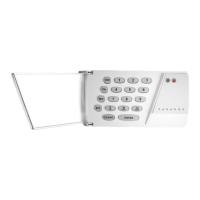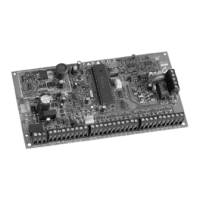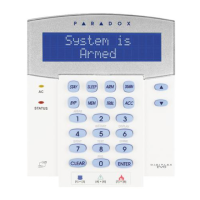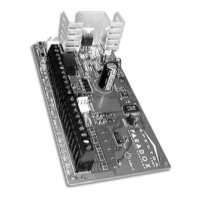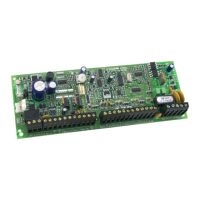
Do you have a question about the Paradox Esprit 728 and is the answer not in the manual?
| Zones | 8 |
|---|---|
| Partitions | 1 |
| StayD mode | Yes |
| Telephone Line Monitoring | Yes |
| Power Supply | 16.5VAC |
| Battery Backup | 12V 7Ah |
| PGMs | 2 (expandable to 6) |
Guidelines for UL listed burglar and fire alarm systems.
Guidelines for Austel-approved installations with transformer specifications.
Guidelines for ULC installations concerning fire alarm systems.
Provides information on panel operation, features, and functions common to all Esprit panels.
Details specifications for various Esprit panel models including zone counts and features.
Highlights the use of powerful RISC processors and SMD Technology for component reduction.
Emphasizes identical programming and software across all Esprit panels for ease of use.
Explains ATZ software allowing 2 zones and tamper on one wire pair, simplifying installation.
Describes simplified keypad programming and easy end-user access to system functions.
Explains partitioning for monitoring two distinct security systems with one panel.
Details fast set-up and reporting using preprogrammed high-speed communicator formats.
Covers the 120-event buffer with time/date and auto-arming capabilities.
Explains activating outputs based on panel status, with options for duration and polarity.
Describes the single pole, double throw dry contacts for alarm output.
Details the 1.2A regulated auxiliary power for detection devices.
Highlights software for panel supervision, programming, and data management.
Details compatibility with telecommunication standards and reporting formats.
Specifies the 120-event buffer with time and date capability.
Lists user codes, partitioning, arming types, and real-time clock functions.
Details zone types, battery charger, aux power, bell output, PGM outputs.
Lists SRI 18, 708, 708DV, and Esprint modules.
Lists compatible LED and LCD keypads and PS1 bedside remote.
Provides current consumption data for panels, keypads, and modules.
Guidance on selecting an installation site for the control panel, considering security and ventilation.
Instructions for connecting the earth terminal to the cabinet and grounding rod.
Specifies transformer requirements for AC input power, including UL/ULC systems.
Details connection of outputs through external relays due to 30mA limit.
Explains connection of warning devices to Bell+/- terminals and auto-shutdown feature.
Describes powering devices with 12VDC from AUX+/- terminals, with overload protection.
Refers to zone connections page and wiring diagram for details.
Explains keypad terminal strip connections and zone input wiring.
Guidance on connecting keypads and performing initial power-up testing.
Recommends using Espload for programming to reduce data entry errors.
Instructions for connecting a 12VDC battery for UL/ULC installations, with warnings.
Explains panel battery testing and the impact of test failures on arming.
Details single zone configurations with N.C./N.O. contacts and EOL resistors.
Details ATZ configuration with 2 zone resistors for tamper recognition.
Provides wiring diagram for ATZ configuration without EOL resistors.
Explains single zone connection without EOL for N.C. contacts.
Describes single zone connection with one EOL for N.C. and N.O. contacts.
Details single zone connection with 1K EOL resistor for tamper recognition.
Details ATZ connection with 2 resistors for tamper and wire fault recognition.
Provides wiring diagram for ATZ configuration with EOL resistors.
Explains options for tamper/wiring failure recognition and ATZ zone doubling.
Details fire zone connection with EOL resistor and UL/ULC requirements.
Recommends detector placement in family living units for optimal fire detection.
Explains how to avoid dead air space near ceiling corners for detector mounting.
Explains keypad numeral representation of zones and status indicators.
Details regular, auto bypass, stay, and fast arming methods.
Covers fast stay arming, double stay, fast exit, disarming, and alarm memory.
Introduces partitioning for dividing zones into two distinct systems.
Details zone assignments for Partition 'A' and 'B'.
Enables partitioning and defines zone assignments for Systems A and B.
Explains how access codes are assigned to arm System 'A' or 'B'.
Details system arming, disarming, and selective arming using codes.
Explains using keyswitch/push button for arming/disarming systems.
Details manual zone bypass using access codes and bypass enabled zones.
Allows reinstatement of the latest zone bypass instructions.
Explains chime programming for keypads and zone chime features.
Describes activating panic alarms via keypad key combinations.
Indicates battery issues and provides troubleshooting steps.
Reports inadequate AC power or power supply issues.
Indicates inadequate AC power to the panel.
Signals that the bell is not connected or requires an EOL resistor.
Indicates excessive bell current causing automatic shutdown.
Signals excessive auxiliary current causing automatic shutdown.
Indicates failure to initiate communication with the central station.
Requires reprogramming of the timer after power failure.
Detects zone line cut/short or tamper faults.
Alerts to a missing telephone line for 30 seconds.
Indicates a fire zone wire cut or open.
Explains setting master and user codes for system access.
Details quick programming using single key presses after [ENTER].
Reports if no movement occurs in a designated time period.
Transmits code if system is not armed by a specified time.
Enables automatic daily arming based on time or no movement.
Explains how programmed times at addresses 245, 246 and 253 are used.
Describes remote programming using Espload software.
Explains keypad programming procedures found in the 'Programming Guide'.
Guides through programming memory locations 000-007 using Hexa input.
Sets the number of rings before the panel answers or enables override.
Sets a four-digit code to identify the panel to the PC for uploading.
Sets a four-digit password to identify the PC for programming download.
Details default and custom installer code setup for programming access.
Guides on programming sections 00 to 34 using streamlined Hexa input.
Configures PC download and central station telephone numbers.
Sets account codes for identification of zones in partitioned systems.
Assigns 2-digit hexa codes for system status reporting.
Assigns hexa report codes to identify users during arming/disarming.
Assigns codes to identify zones generating alarms or restoring.
Transmits restoration codes to indicate trouble rectification.
Reports 8 trouble status codes to the central station.
Transmits restoration codes for rectified trouble conditions.
Assigns codes to report 10 special status conditions.
Details available communicator formats like Contact ID and Ademco Express.
Lists preprogrammed Contact ID event codes and reporting addresses.
Selects specific report codes to be transmitted.
Details high-speed reporting format communicating events in 2 seconds.
Format for reporting without central station receiver connection.
Defines PGM output as N.O. or N.C., and timed options.
Programs PGM output to operate based on logical event combinations.
Provides a table of PGM functions, descriptions, types, and hexa programming.
Assigns user codes to specific arming functions like 'stay' or 'away'.
Defines user code assignments for System 'A' and 'B'.
Configures Telephone Line Monitor options for trouble or alarm indication.
Enables PS1 or keyswitch for arming/disarming system.
Programs panel to call PC back for verification during communication.
Programs automatic daily arming at a specified time.
Enables auto-arming or reporting based on inactivity.
Selects tone or pulse dialing for communication.
Activates partitioning and defines zone assignments for Systems A and B.
Enables central station reporting and assigns reporting codes.
Configures silent zones/panics to generate only reports.
Sets pulse time ratio for Espload communication.
Sends system reports to Tel #2, and alarm reports to Tel #1.
Transmits all reports to both programmed telephone numbers.
Answers calls from answering machines to allow modem access.
Enables a brief bell sound on arming and disarming.
Automatically bypasses zones initiating 4 consecutive alarms.
Initiates upload of event buffer to PC when it becomes full.
Enables Panic 1, 2, and 3 signals on the keypad.
Sets keypad panic signals as silent, audible, or fire.
Configures panic keys to sound silent alarms or reports.
Activates audible alarm output when panic keys are used.
Activates pulsed audible alarm output for fire panic conditions.
Enables quick 'full' or 'stay' arming by pressing a single key.
Sets user and installer codes to 6 or 4 digits.
References pages for tamper/wire fault definition details.
Enables keypad beeping during exit delay, increasing in frequency.
Configures immediate or delayed transmission of zone restoration codes.
Refers to pages for loop configuration and EOL resistor details.
Sets whether disarm codes are always reported or only after an alarm.
Prevents AC failure from displaying on the keypad's trouble indicator.
Disables burglar alarm zone for fire zone wire faults.
Configures auto-arming for regular or 'stay' arming.
Enables auto-bypass (away) arming when regular code is entered.
Prevents system arming if battery failure or low voltage is present.
Prevents arming if tamper fault is present; requires installer reset.
Determines if device tamper follows zone bypass.
Controls which bypass report code is transmitted.
Enables ATZ for two zones per circuit, not for 718/748ES.
Enables intermittent audible trouble warnings on keypad.
Verifies keypad presence and regards undetected keypads as 'open'.
Defines zones 13-24, not available on all models.
Configures zone response time for slow or fast detection.
Assigns zones to trigger silent alarms or audible alarms.
Defines zones as 24-hour, fire, or regular, with priority for fire zones.
Defines zones that generate an immediate alarm when opened.
Defines zones that switch to 'delay' during entry delay.
Assigns zones to 'Delay 2' definition for entry delay.
Enables zones for bypass during manual, away, or auto shut-down arming.
Assigns zones to common, Partition A, or Partition B.
Sets the duration in days for auto test reports.
Configures auto-arming, late to close reports, and no movement reports.
Sets the exit delay duration in seconds upon arming.
Sets the primary entry delay duration in seconds.
Sets the secondary entry delay duration in seconds.
Sets the maximum duration for the bell output in minutes.
Sets zone response time for non-fast zones.
Sets delay for AC report code transmission.
Sets time for 'no movement' report or auto arming.
Sets duration for PGM output activation in minutes or seconds.
Locks installer programming to prevent changes.
Procedures for resetting panel to factory defaults.
Resets panel to defaults by removing AC and battery power.
Resets panel to defaults using installer code and [STAY] key.
Details warranty conditions and exclusions for the ESPRIT system.
Disclaims liability for damages related to product purchase or use.
Advises frequent testing of the security system for proper performance.
States compliance with FCC rules and provides registration information.
Instructs customer to notify phone company of connection details.
Provides the FCC registration number for the equipment.
Provides the Ringer Equivalence Number (REN).
Specifies the USOC jack type for connection.
Details requirements for connecting to the telephone network.
Addresses potential harm to telephone network and temporary service disconnection.
Explains telephone company's right to change facilities with prior notice.
States limitations on using coin telephone lines and party lines.
Explains REN for determining quantity of devices on a telephone line.
Provides information on obtaining service or repairs for telephone equipment.
Provides contact information for Paradox U.S.
Provides warnings and user instructions for Class B digital devices.
Warns that unauthorized modifications may void user authority.
Identifies certified equipment and limitations of Industry Canada certification.
Details Industry Canada material approval and connection restrictions.
Advises users not to attempt electrical connection work themselves.
